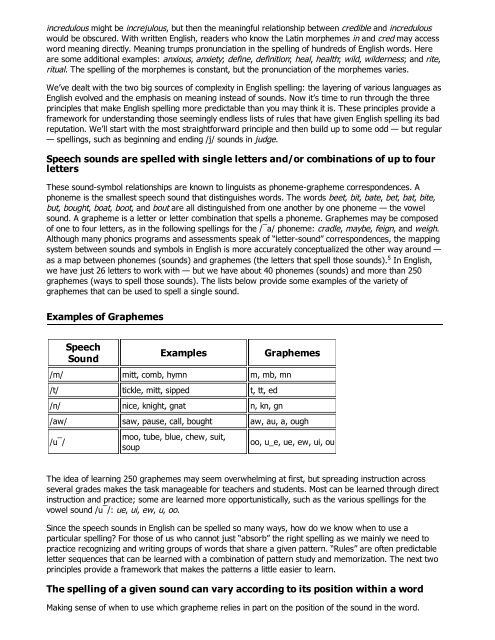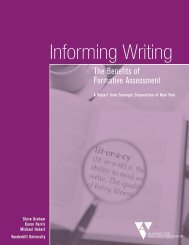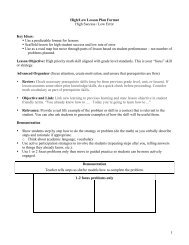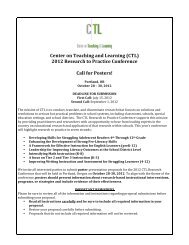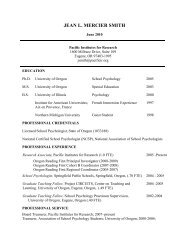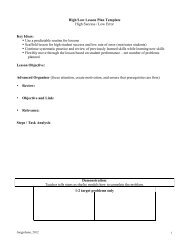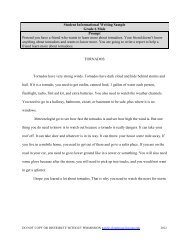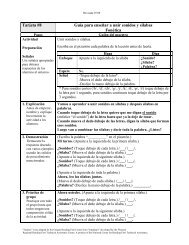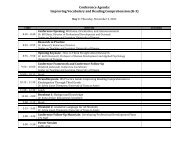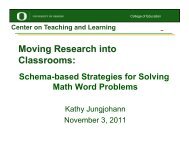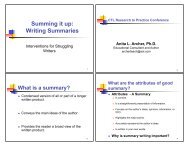How Spelling Supports Reading - Center on Teaching and Learning
How Spelling Supports Reading - Center on Teaching and Learning
How Spelling Supports Reading - Center on Teaching and Learning
You also want an ePaper? Increase the reach of your titles
YUMPU automatically turns print PDFs into web optimized ePapers that Google loves.
incredulous might be increjulous, but then the meaningful relati<strong>on</strong>ship between credible <strong>and</strong> incredulouswould be obscured. With written English, readers who know the Latin morphemes in <strong>and</strong> cred may accessword meaning directly. Meaning trumps pr<strong>on</strong>unciati<strong>on</strong> in the spelling of hundreds of English words. Hereare some additi<strong>on</strong>al examples: anxious, anxiety; define, definiti<strong>on</strong>; heal, health; wild, wilderness; <strong>and</strong> rite,ritual. The spelling of the morphemes is c<strong>on</strong>stant, but the pr<strong>on</strong>unciati<strong>on</strong> of the morphemes varies.We’ve dealt with the two big sources of complexity in English spelling: the layering of various languages asEnglish evolved <strong>and</strong> the emphasis <strong>on</strong> meaning instead of sounds. Now it’s time to run through the threeprinciples that make English spelling more predictable than you may think it is. These principles provide aframework for underst<strong>and</strong>ing those seemingly endless lists of rules that have given English spelling its badreputati<strong>on</strong>. We’ll start with the most straightforward principle <strong>and</strong> then build up to some odd — but regular— spellings, such as beginning <strong>and</strong> ending /j/ sounds in judge.Speech sounds are spelled with single letters <strong>and</strong>/or combinati<strong>on</strong>s of up to fourlettersThese sound-symbol relati<strong>on</strong>ships are known to linguists as ph<strong>on</strong>eme-grapheme corresp<strong>on</strong>dences. Aph<strong>on</strong>eme is the smallest speech sound that distinguishes words. The words beet, bit, bate, bet, bat, bite,but, bought, boat, boot, <strong>and</strong> bout are all distinguished from <strong>on</strong>e another by <strong>on</strong>e ph<strong>on</strong>eme — the vowelsound. A grapheme is a letter or letter combinati<strong>on</strong> that spells a ph<strong>on</strong>eme. Graphemes may be composedof <strong>on</strong>e to four letters, as in the following spellings for the /!a/ ph<strong>on</strong>eme: cradle, maybe, feign, <strong>and</strong> weigh.Although many ph<strong>on</strong>ics programs <strong>and</strong> assessments speak of “letter-sound” corresp<strong>on</strong>dences, the mappingsystem between sounds <strong>and</strong> symbols in English is more accurately c<strong>on</strong>ceptualized the other way around —as a map between ph<strong>on</strong>emes (sounds) <strong>and</strong> graphemes (the letters that spell those sounds). 5 In English,we have just 26 letters to work with — but we have about 40 ph<strong>on</strong>emes (sounds) <strong>and</strong> more than 250graphemes (ways to spell those sounds). The lists below provide some examples of the variety ofgraphemes that can be used to spell a single sound.Examples of GraphemesSpeechSoundExamples/m/ mitt, comb, hymn m, mb, mn/t/ tickle, mitt, sipped t, tt, ed/n/ nice, knight, gnat n, kn, gnGraphemes/aw/ saw, pause, call, bought aw, au, a, ough/u!/moo, tube, blue, chew, suit,soupoo, u_e, ue, ew, ui, ouThe idea of learning 250 graphemes may seem overwhelming at first, but spreading instructi<strong>on</strong> acrossseveral grades makes the task manageable for teachers <strong>and</strong> students. Most can be learned through directinstructi<strong>on</strong> <strong>and</strong> practice; some are learned more opportunistically, such as the various spellings for thevowel sound /u!/: ue, ui, ew, u, oo.Since the speech sounds in English can be spelled so many ways, how do we know when to use aparticular spelling? For those of us who cannot just “absorb” the right spelling as we mainly we need topractice recognizing <strong>and</strong> writing groups of words that share a given pattern. “Rules” are often predictableletter sequences that can be learned with a combinati<strong>on</strong> of pattern study <strong>and</strong> memorizati<strong>on</strong>. The next twoprinciples provide a framework that makes the patterns a little easier to learn.The spelling of a given sound can vary according to its positi<strong>on</strong> within a wordMaking sense of when to use which grapheme relies in part <strong>on</strong> the positi<strong>on</strong> of the sound in the word.


